Walkers for Seniors: Our Complete Guide
Understanding the Importance of Walkers for Seniors
The Critical Role of Mobility in Senior Health and Independence
Mobility is a cornerstone of senior health and independence. As people age, the ability to move freely becomes integral to their quality of life. Lack of mobility can lead to a series of complications, both physical and psychological. For instance, immobility increases the risk of blood clots, muscle atrophy, and can even lead to anxiety and depression.
However, with the right support and tools, seniors can maintain good mobility. This is where mobility aids like walkers come into play. Walkers provide the physical support needed to move around safely and empower the elderly to perform their day-to-day activities with ease. In essence, they serve as crucial stability aids that help maintain an active lifestyle, thereby contributing to improved mental and physical well-being.
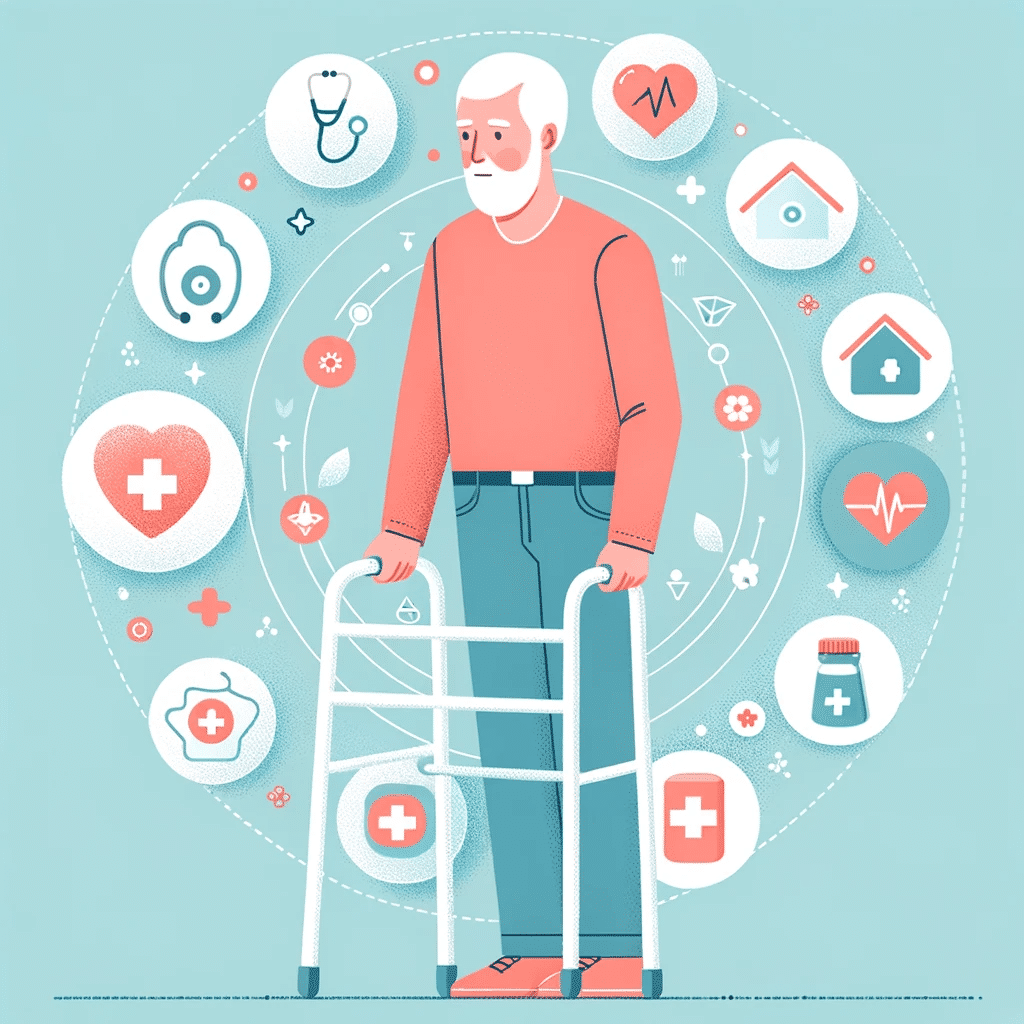
How Mobility Aids Enhance Elderly Support and Safety
Safety is a prime concern when it comes to senior mobility. The bones and muscles weaken, making the elderly more susceptible to falls and accidents. According to the Centers for Disease Control and Prevention (CDC), one out of four older adults falls each year, and falls are the leading cause of both fatal and non-fatal injuries among seniors.
Mobility aids, specifically walkers, address this concern by offering enhanced stability and balance support. These devices significantly reduce the chances of mishaps, equipped with features like non-slip grips and adjustable heights. Moreover, they are often designed keeping in mind the specific needs of the elderly, such as lightweight frames for easy maneuverability and padded seats for added comfort during prolonged use.
Through facilitating walking assistance, mobility aids like walkers create an environment where seniors can navigate their surroundings safely and with confidence. By doing so, these crucial devices not only provide physical support but also offer mental peace of mind, both for the seniors and their loved ones.

Whether it’s for rehabilitation equipment after surgery or for daily use, walkers have proven to be invaluable assets in elderly care, ensuring both safety and independence. With the help of these mobility solutions, seniors can continue to participate in activities they enjoy, from a simple walk in the park to shopping, thereby leading a fuller, more active life.
By understanding the importance of mobility aids, we set the foundation for choosing the right type of walking assistance, be it traditional walkers, rollators, or specialized medical walkers. The key is to prioritize safety and comfort, taking into account the unique needs and preferences of the senior in question.
In the following sections, we’ll delve deeper into the different types of walkers available, their features, and how to make the most out of them. Stay tuned to explore the world of walkers and find the perfect mobility solution for you or your loved one.
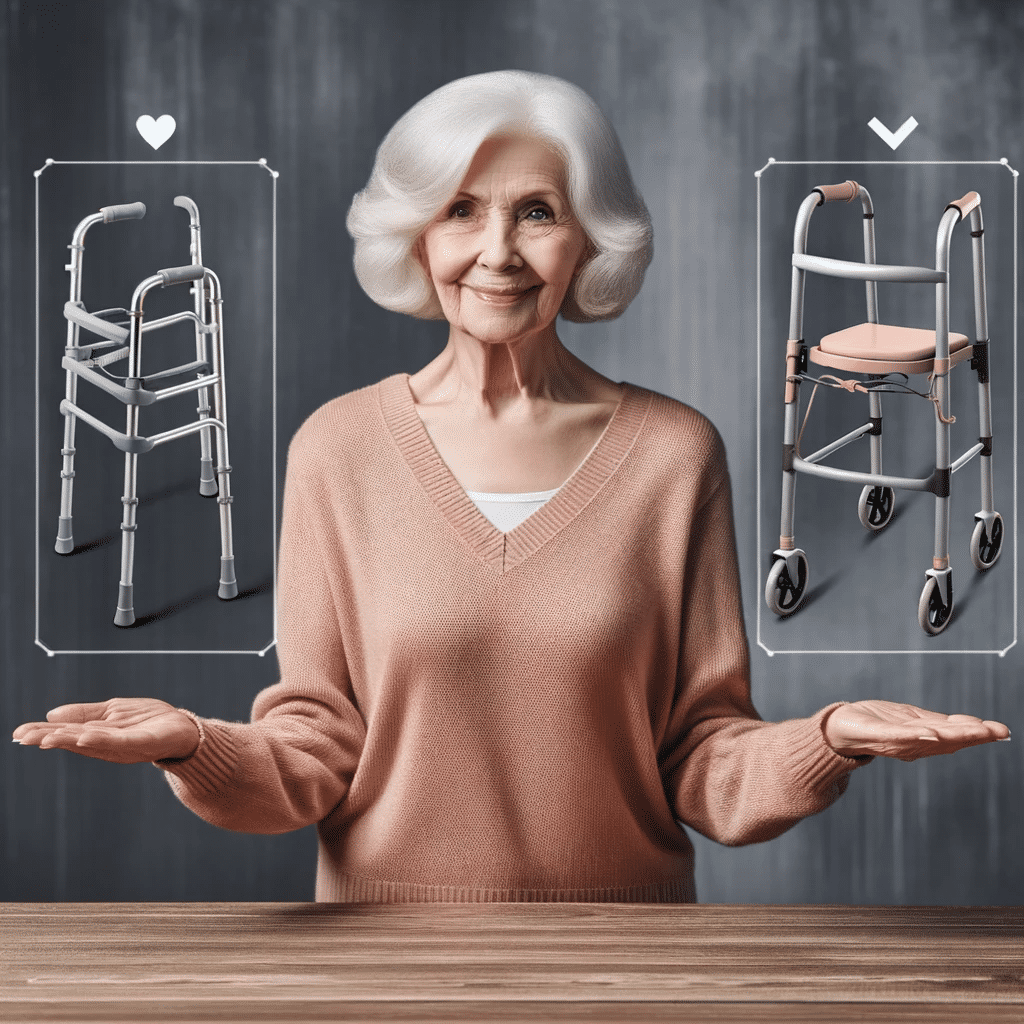
Walkers vs. Rollators: What’s the Difference?
Introduction to Walking Frames and Their Design
Walkers and rollators are both assistive devices designed to aid with walking, but they serve different needs and come with distinct features. At its core, a walking frame is a simple structure consisting of a set of legs and handles. The user lifts and places the frame a step ahead, holds the handles, and then steps forward. Many walking frames come with front wheels for easier maneuvering, but they generally don’t have wheels on all four legs, unlike rollators.
Rollators: Features, Advantages, and When to Choose Them
Rollators, also known as “rolling walkers,” come equipped with wheels on all four legs, usually accompanied by locking brakes for safety. They often include added features like padded seats, backrests, and storage baskets. Because of the wheels, rollators don’t need to be lifted off the ground, making them easier to use for individuals who lack upper body strength.
Advantages:
- Ease of Use: No need to lift the frame, reducing upper body strain.
- Mobility: Better for covering longer distances.
- Additional Features: Storage and seating options available.
When to Choose:
- When the user has good balance but lacks stamina for extended walking.
- When the walking surface is smooth and obstacle-free.
- When the user desires additional features like a seat or storage basket.
Traditional Walkers: Benefits and Ideal Scenarios for Use
Traditional walkers are simpler, usually consisting of a metal frame with four legs. They provide a lot of stability but require more upper body strength as they need to be lifted with each step.
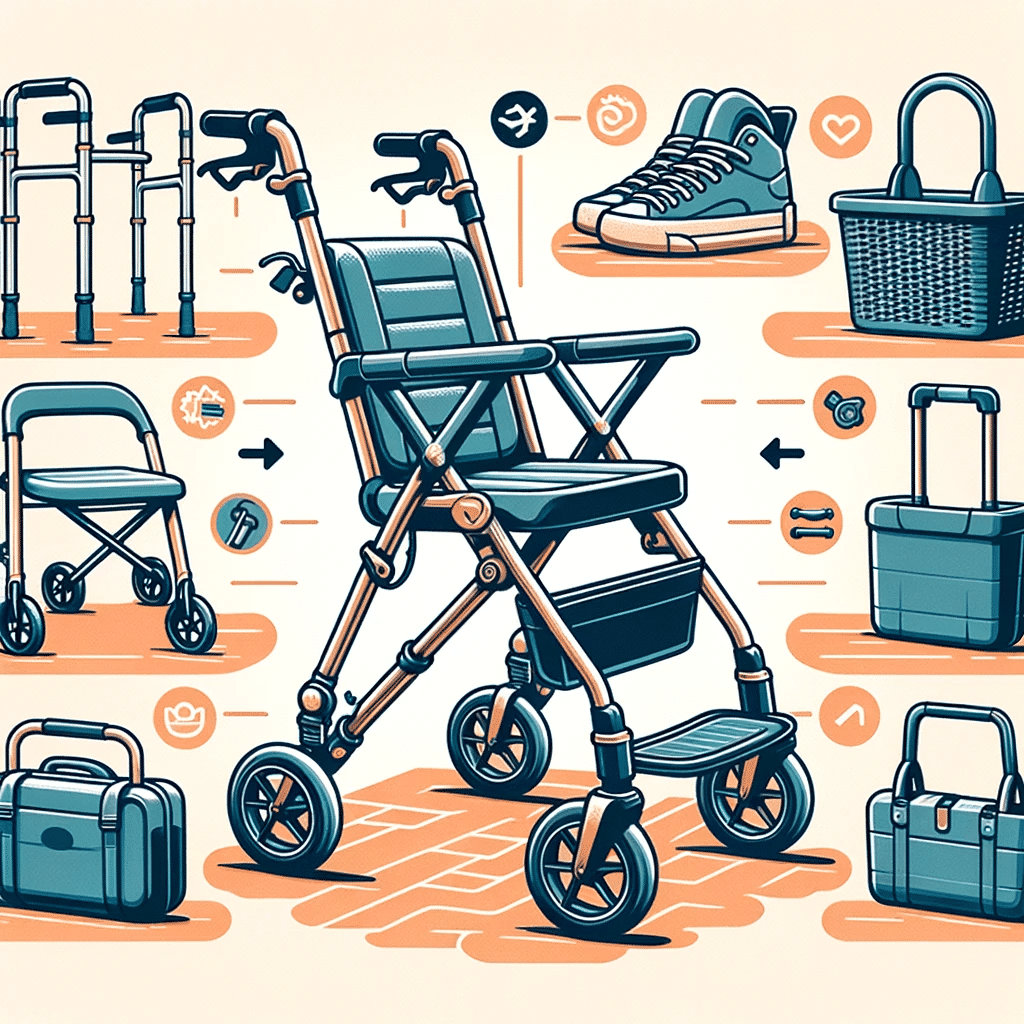
Benefits:
- Stability: Excellent for users with poor balance.
- Cost: Generally less expensive than rollators.
- Weight: Lighter and easier to transport.
Ideal Scenarios:
- When the user requires maximum balance support.
- When upper body strength is good enough to lift the walker.
- For indoor use where the walking surface is limited or uneven.
Key Features to Look for in Walkers for Seniors
Adjustable Height for User Comfort
Comfort is a crucial factor when selecting a walker. Look for models that offer adjustable height settings to ensure a personalized fit. The handles should be at wrist height when the user is standing upright, allowing for a slight bend in the elbows.
Non-Slip Grips for Safety and Stability
Safety should be your paramount concern. Walkers with non-slip grips ensure that the user has a secure hold at all times, reducing the risk of accidents. These are particularly useful in conditions where the hands might get sweaty or wet.
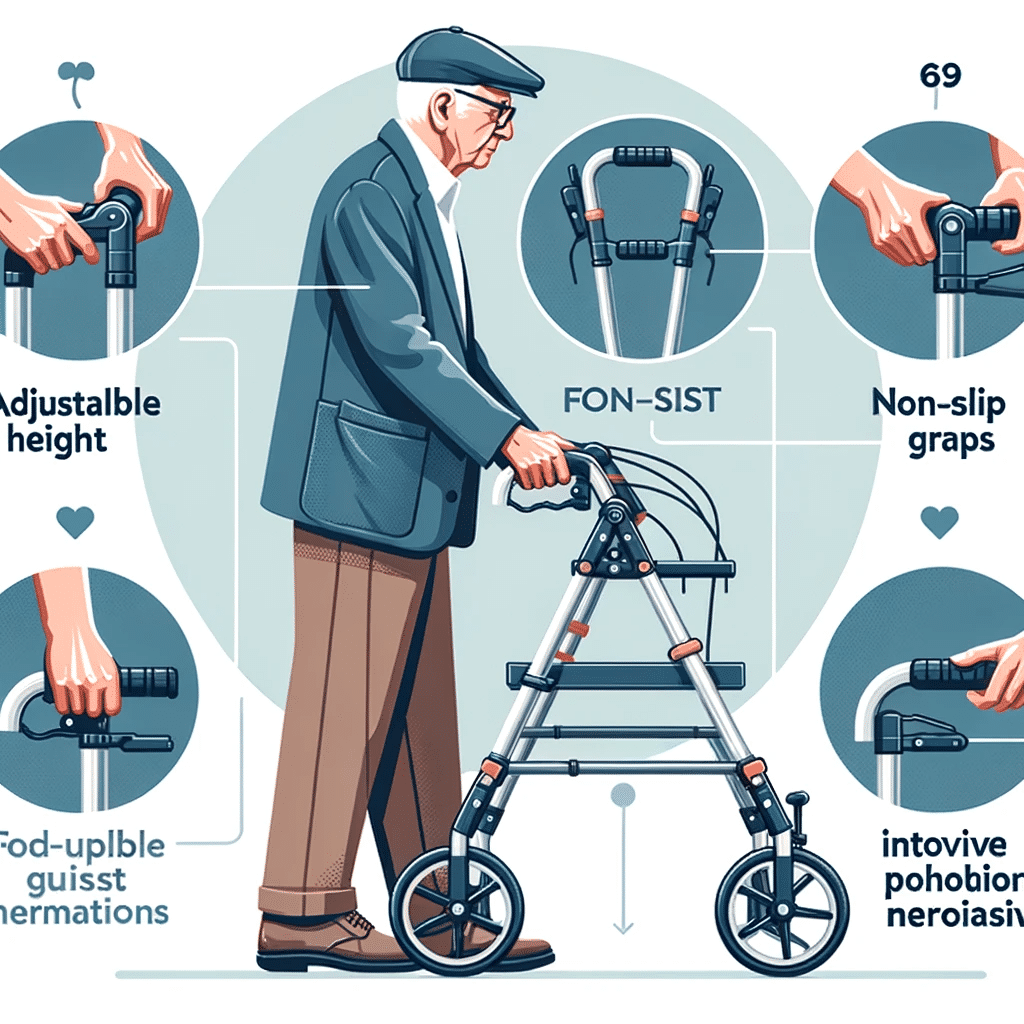
The Convenience of Folding Walkers for Storage and Transportation
For seniors who travel or have limited living space, a folding walker is a godsend. These can be folded flat for easy storage in a car trunk or a closet. Always ensure that the folding mechanism is easy to operate and locks securely in place when unfolded.
The Innovation of Upright Walkers and Their Ergonomic Benefits
Upright walkers are a recent innovation in the world of mobility aids. Unlike traditional models, these allow the user to walk in a more natural, upright position. This design helps in reducing back pain and encourages better posture. Ideal for users who have the strength to stand upright but need support while walking.
By paying attention to these key features, you can ensure that the walker you choose not only meets your mobility needs but also offers comfort, safety, and convenience. Whether it’s a traditional walker or a more specialized rollator, each has its unique set of features designed to enhance senior mobility. Make your choice based on the individual needs and scenarios where the walker will be most frequently used.
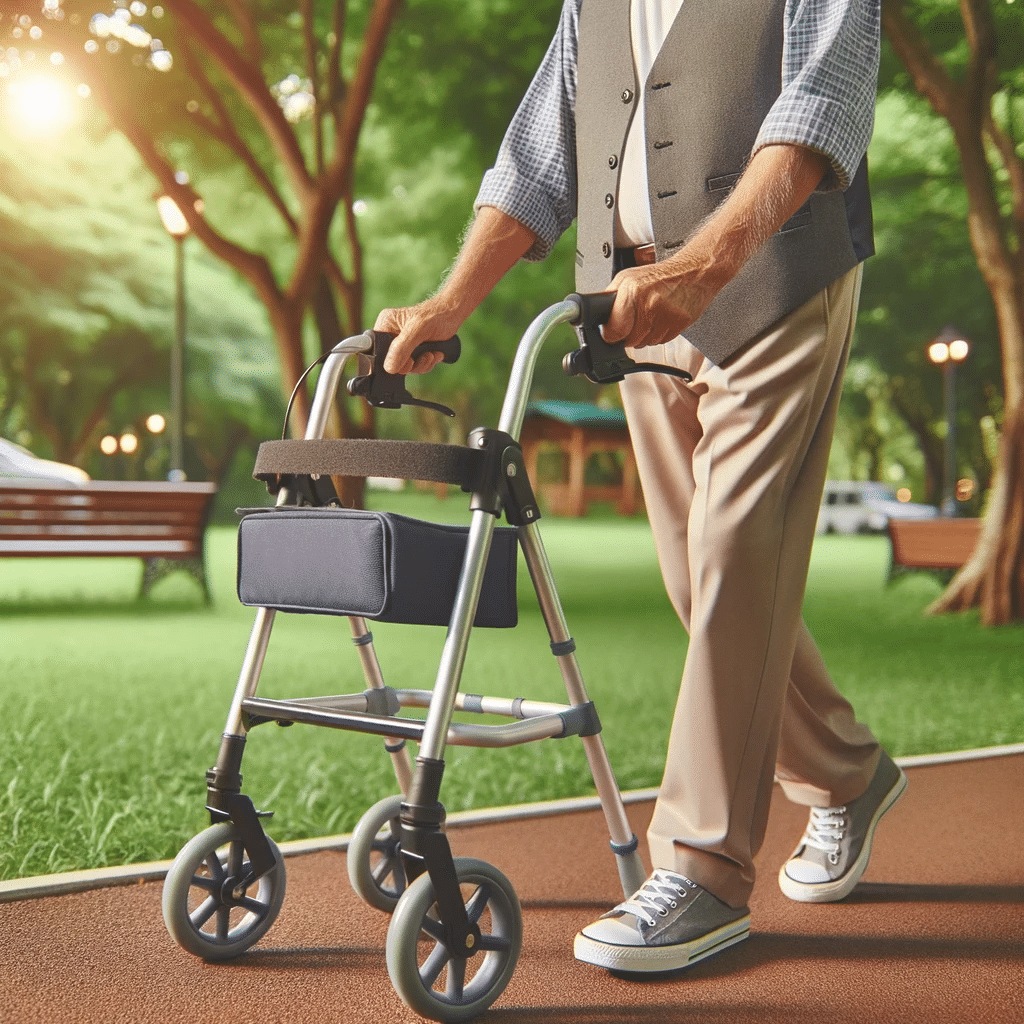
Diving Deeper: Specialized Walkers and Their Uses
Four-Wheel Walkers and Their Added Mobility
Four-wheel walkers are essentially rollators and offer a heightened sense of mobility compared to traditional walkers. With wheels on each leg, these walkers provide a smooth, effortless movement across various terrains. They are ideal for seniors who need to cover more distance, perhaps while shopping or taking extended outdoor walks. However, it’s crucial to note that four-wheel walkers are best suited for those who do not require substantial balance support but need a device to lean on for stability.
Medical Walkers for Rehabilitation and Post-Surgery Use
Medical walkers are specialized mobility aids designed for people recovering from surgeries or those undergoing rehabilitation. These are often prescribed by healthcare professionals and are tailored to meet specific medical conditions. For instance, a knee walker is perfect for someone who has undergone knee surgery and cannot put weight on one leg. By catering to specific medical needs, these walkers play a pivotal role in speeding up the recovery process.
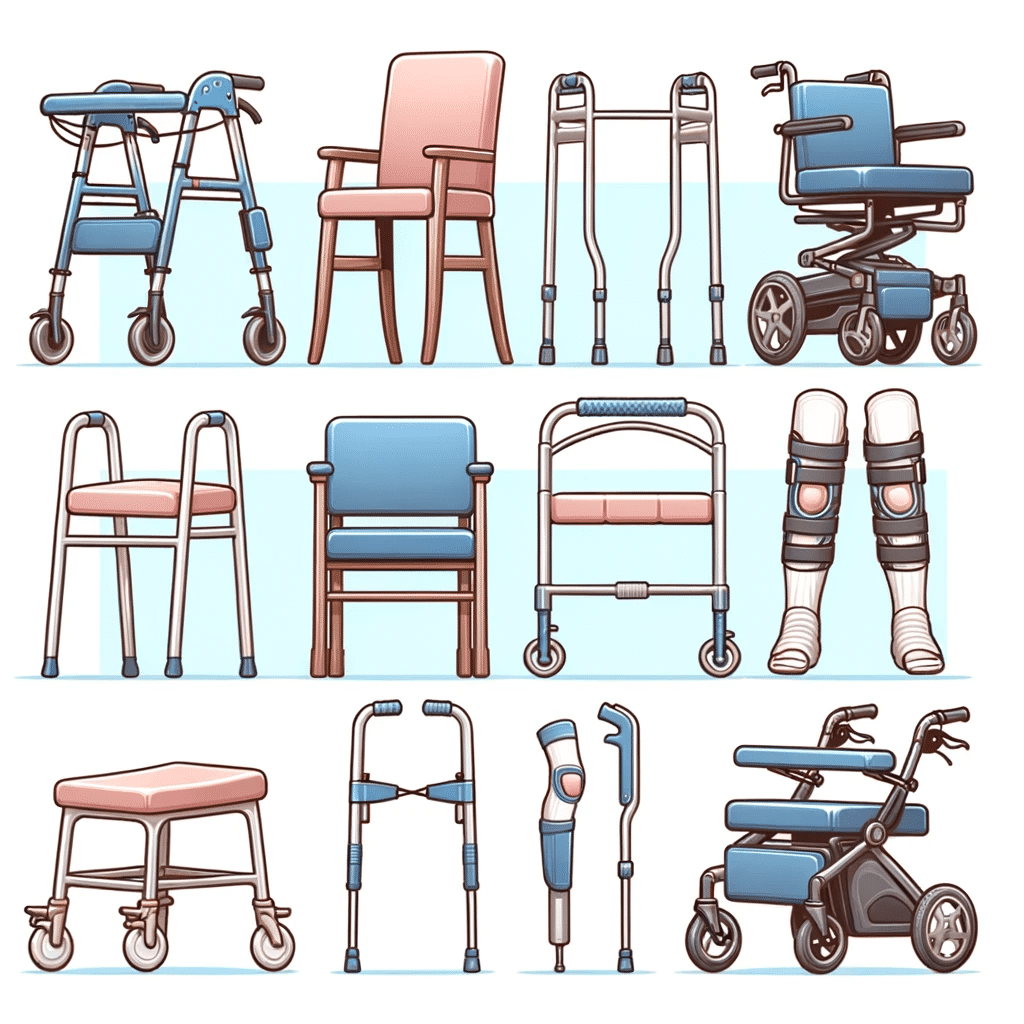
Walkers with Padded Seats and Backrests: Comfort on the Go
Many modern walkers come equipped with padded seats and backrests, providing a comfortable option for seniors to rest during long walks. This feature is particularly beneficial for those who might lack the stamina to stand or walk for extended periods. By offering a seating solution, these walkers encourage seniors to maintain an active lifestyle without overexerting themselves.
The Importance of Locking Brakes in Certain Models
For any walker with wheels, locking brakes are a critical safety feature. They allow the user to secure the walker in place, which is particularly useful when standing from a seated position or while resting. This feature becomes even more critical in four-wheel walkers or rollators, where the risk of the device rolling away can lead to falls or other injuries.
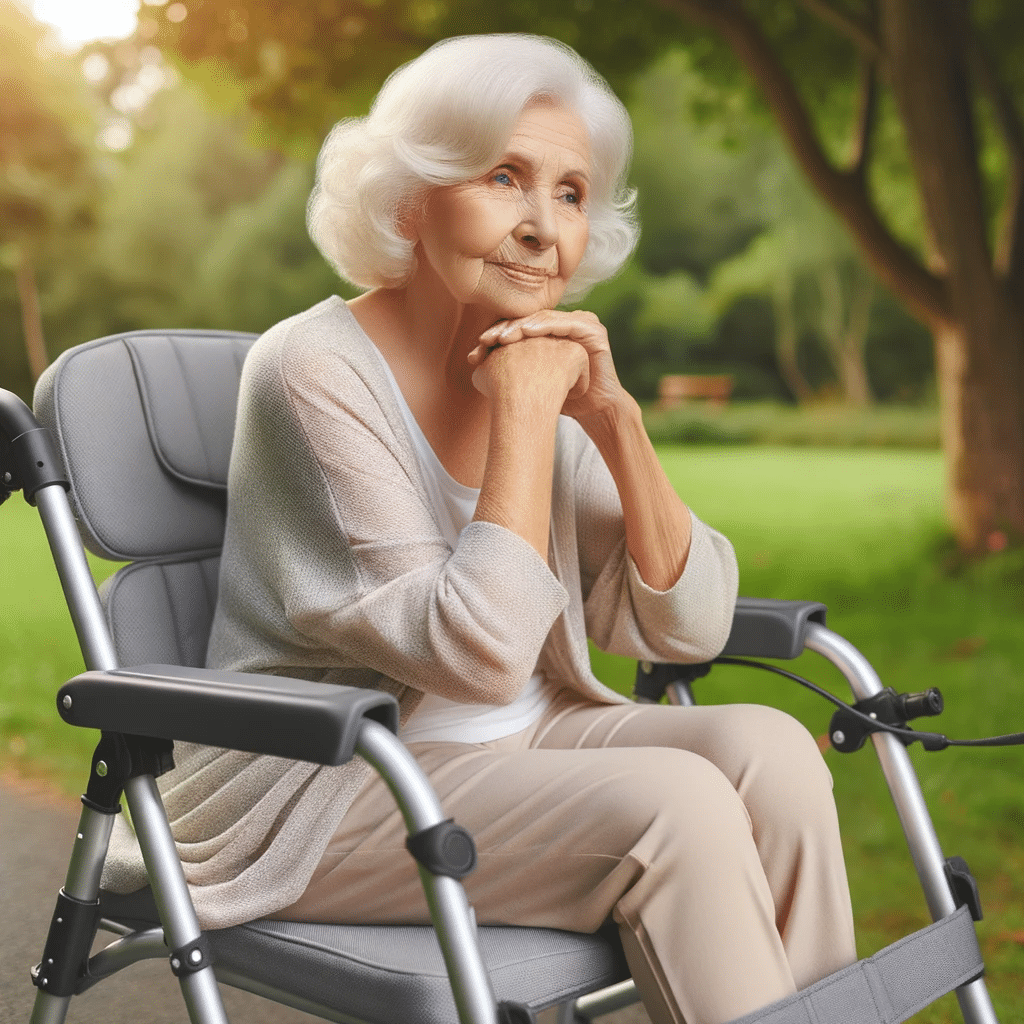
Making the Most of Your Walker: Useful Accessories and Add-ons
Walker Bags: Carrying Essentials with Ease
One of the challenges seniors face while using a walker is carrying personal items. This issue is easily resolved with walker bags, which can be attached to the frame. These bags are excellent for carrying essentials like medications, water bottles, and even groceries, making them a practical add-on for everyday activities.
Safety Handles and Their Role in Enhancing Grip
In addition to the standard grips found on most walkers, some models offer the option to add safety handles. These are usually larger, more ergonomically designed grips that provide an enhanced hold. They are particularly useful for those with arthritis or other conditions that might affect hand strength and dexterity.
Hand Brakes and Their Significance in Hilly Areas
If you reside in an area with slopes or hills, hand brakes are a must-have feature. Just like the brakes on a bicycle, these allow the user to control the speed of the walker when moving downhill. This is a critical safety feature that can prevent accidents and give the user greater control over the walker’s movement.
In conclusion, specialized walkers and their respective accessories serve various needs, from medical rehabilitation to enhanced outdoor mobility. By considering these features and add-ons, you can tailor your walker to better suit your lifestyle, ensuring both safety and convenience.

Elderly Care: Ensuring Safe Use of Walkers
Training Seniors for Proper Use of Mobility Aids
Before a senior starts using a walker, proper training is indispensable. Consult with healthcare professionals to ensure that the walker is adjusted to the correct height and that the user knows how to navigate it safely. Many organizations and senior centers offer training sessions on how to properly use mobility aids, focusing on grip, posture, and movement. This instruction helps to mitigate the risk of falls and ensures that the senior can use the walker with confidence.
The Balance Between Independence and Supervised Use
One of the main goals of using a walker is to promote independence among seniors, but this needs to be balanced with supervised use, especially in the beginning. When first using the walker, the senior should have someone present to ensure that they can manage it safely. As confidence and ability grow, supervised use can taper off, but it’s crucial to continue regular check-ins to ensure that the walker remains in good condition and the senior is using it correctly.
Addressing Common Concerns and Frequently Asked Questions
When introducing a walker, seniors and caregivers alike often have numerous questions and concerns. These can range from how to adjust the walker to specific health-related questions like how to use the walker post-surgery. Create a list of FAQs, or consult resources and healthcare providers for answers to these questions. This information can be invaluable for increasing the comfort level of both the senior and the caregiver.
Beyond Walkers: Exploring Other Assistive Devices
Wheelchair Alternatives for Varied Mobility Needs
Walkers are just one piece of the broader mobility solution landscape. Wheelchairs, both manual and electric, are another common option. However, other alternatives like mobility scooters and stair lifts can also be considered based on individual needs and the layout of the home. Each option comes with its own set of advantages and disadvantages, and consulting with a healthcare provider can help determine the most appropriate solution.
Portable Solutions for Traveling Seniors
For seniors who travel, portable mobility aids such as foldable wheelchairs or travel rollators offer a convenient option. These lightweight devices can be easily packed into a car or checked in during air travel, allowing seniors to maintain their mobility while away from home. Always check the specifications, weight limits, and folding mechanisms before making a purchase to ensure it suits your travel needs.

The Future of Mobility Solutions and Upcoming Innovations
As technology advances, so does the field of mobility solutions. In the pipeline are devices with smart features such as GPS tracking, fall detection, and even walkers with automated braking systems. Research and development are also focusing on wearable assistive devices that can aid mobility without the need for a walker or wheelchair. These innovations aim to provide seniors with safer, more convenient ways to maintain independence as they age.
Through proper training and ongoing education, seniors can make the most out of their walkers and other assistive devices. Understanding the balance between independence and supervised use, addressing common concerns, and exploring other mobility options are essential steps in ensuring both safety and freedom of movement. As we look forward to future innovations in this field, the ultimate aim remains constant: to enhance the quality of life for seniors through improved mobility.
Resources and Recommendations
List of Top Walker Brands and Their Standout Features
When it comes to selecting a walker, brand reputation can be a significant deciding factor. Some of the top brands in the walker industry include Drive Medical, Medline, and Nova. Each brand offers various features catering to different needs:
- Drive Medical: Known for their durable and lightweight walkers, many of their models come with easy-to-operate folding mechanisms for convenient storage and travel.
- Medline: Specializes in rollators with extra features like padded seats and backrests, offering both comfort and utility.
- Nova: Renowned for their heavy-duty rollators, they provide options that include larger wheels and advanced braking systems for increased safety.
Helpful Resources for Choosing the Right Mobility Aid
Selecting the right walker can be overwhelming, given the variety of options available. Resources like Consumer Reports, healthcare blogs, and user reviews can be helpful in narrowing down your choices. Don’t forget to consult your healthcare provider, who can offer personalized advice based on your medical history and mobility needs.
Conclusion on Walkers for Seniors
Emphasizing the Role of Walkers in Senior Health and Independence
Walkers play an indispensable role in promoting senior health and independence. They provide the support needed to continue with daily activities, from basic chores to leisurely outdoor walks, all while offering an enhanced level of safety.
Resources: Tips for choosing and using walkers, A guide for choosing the best walkers for seniors, Walkers for Seniors: A Complete Guide
See our other article on walkers!
Upright Walkers for Seniors #1 Guide
Upright Walkers for Seniors – 2024 Best 5 Review
Best Walkers for Seniors on a Budget
Rollator Walkers vs Regular Walkers, what’s best in 2024?
Walkers for Adults: Great Mobility in 2024
Walkers for Seniors: Our Complete Guide
Three Wheel Walker: #1 Best Picks & Buying Tips for Seniors
Drive Walker with Seat for Seniors – Top 5 in 2024
Upright Walkers for Seniors – 2024 Best 5 Review
JustforSeniors.org – Health & Wellness
